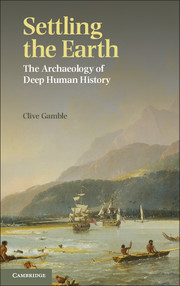Book contents
- Frontmatter
- Dedication
- Contents
- List of boxes
- List of figures
- List of tables
- Acknowledgements
- Glossary
- Web resources for skulls and stone tools
- 1 The worlds of deep human history
- 2 The drivers of climate and environment: Terrae 0–2, 10Ma–50ka
- 3 The recent veneers of climate, environment and population: Terrae 3–5, 50ka to the present day
- 4 Walking and running down the tectonic trail: Terra 0, 10–3.3Ma, and Terra 1, 3.3–1.8Ma
- 5 Three strides across a bio-tidal world: Terra 2, 1.8Ma–50ka
- 6 Going beyond, keeping in touch: Terra 3, 50–4ka
- 7 The call of the north: Terra 3, 50–4ka
- 8 Eyes on the horizon: Terra 4, 4–1ka
- 9 The human reunion in retrospect: Terra 5, after 1400 AD
- Bibliography
- Index
6 - Going beyond, keeping in touch: Terra 3, 50–4ka
Published online by Cambridge University Press: 05 June 2014
- Frontmatter
- Dedication
- Contents
- List of boxes
- List of figures
- List of tables
- Acknowledgements
- Glossary
- Web resources for skulls and stone tools
- 1 The worlds of deep human history
- 2 The drivers of climate and environment: Terrae 0–2, 10Ma–50ka
- 3 The recent veneers of climate, environment and population: Terrae 3–5, 50ka to the present day
- 4 Walking and running down the tectonic trail: Terra 0, 10–3.3Ma, and Terra 1, 3.3–1.8Ma
- 5 Three strides across a bio-tidal world: Terra 2, 1.8Ma–50ka
- 6 Going beyond, keeping in touch: Terra 3, 50–4ka
- 7 The call of the north: Terra 3, 50–4ka
- 8 Eyes on the horizon: Terra 4, 4–1ka
- 9 The human reunion in retrospect: Terra 5, after 1400 AD
- Bibliography
- Index
Summary
What country, friends, is this?
Viola, Twelfth Night, Act 1, Scene 2Brave New Worlds
Terra 3 is a riot of human rather than hominin imagination. In a short span, the boundaries of Terra 2 are far exceeded as, for the first time, hominins cross oceans and settle arid continental interiors. And in the process, there is archaeological evidence for innovation in technology, imaginative geographies of the living and the dead and the increased reach of social networks. Dispersal in Terra 3 is also charted by archaeogenetic data that indicate when regional populations arose and where from. Broad patterns at a continental scale come from the study of modern DNA, while a small sample of ancient genomes is beginning to add colour and complexity to the geographical patterns of population dispersal.
In terms of the hominin bauplan, there is little to add (Table 5.2). Maximum body and brain sizes were achieved during the third stride in Terra 2. However, it is during Terra 3 that the Sapiens dispersals occur into the continents of Australia, North and South America and throughout Siberia and the Arctic. These indicate a remarkably versatile approach to environments that fluctuated from full ice age to interglacial. And this plasticity brings significant biological developments among Homo sapiens who become ever more gracile in their skeletal build. This gracilisation is especially the case with the onset of the Holocene warming. Now regional diversity in human body shape and cranial architecture adapt sensitively to temperature and precipitation. Other phenotypic differences represent further regional adaptations: skin colour to low UVB levels, variation in the immune system to waterborne disease and adaptations to altitude and the effects of hypoxia (Table 2.6). But the human diversity that confronts the bio-anthropologist studying living populations eludes the palaeoanthropologist working with older samples. Regional variation across Terra 3 in skin colour and variation in hair type will have to wait for more ancient DNA work rather than a larger sample of fossil skulls.
- Type
- Chapter
- Information
- Settling the EarthThe Archaeology of Deep Human History, pp. 188 - 226Publisher: Cambridge University PressPrint publication year: 2013



